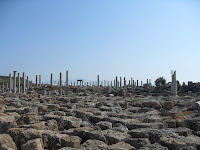The end of August was marked with a holiday because of the end of Ramadan celebration, Eid ul-Fitr. As you can tell from my previous posts, we have not been doing too much “work” to need a vacation, but it was nice for Josh and I to get away and explore a bit of Turkey by ourselves. We decided to head for the western Mediterranean city of Antalya.
Since the month of September marks Josh's birthday and our wedding anniversary, we decided to splurge a bit and booked a room at the Alp Paşa Hotel. It is a boutique hotel in Kaleici (Old Town) that inhabits several of the old Ottoman mansions that were originally built in the mid-18th to early-19th centuries for wealthy merchants. While it was a bit expensive, it was definitely a beautiful place to make as our home base for our adventures in the city.
The streets of the Kaleici are charming and whimsical--very narrow, cobblestoned with beautiful flowers and plants everywhere. There are little shops around every corner selling everything from carpets, scarves, spices, and nargiles (aka hookah or water pipe) to modern clothing and knock-off name-brand bags. The shop keepers did get a bit relentless, and some even followed us down the street shouting “Yes, Please!” even though we kept saying “No, Thank you!”
The Old Town winds its way down to a beautiful marina backdropped by rugged mountain cliffs. It is definitely a stunning site, and made for some spectacular sunsets.
One thing that has been particularly striking to me since arriving in Turkey is the centuries of history that surround me on a daily basis. This is particularly true for the Antalya area. Archeological finds in some of the caves in the region date back to the Paleolithic period with the skull of a neanderthal child.
Josh and I spent a good portion of one afternoon in the Antalya Museum immersing ourselves in the history and archeological finds of the region. It is a very beautiful and extensive museum. I highly recommend to anyone.
Now for the history lesson portion of this blog:
 |
| Hadrian's Gate |
The city of Antalya was founded in the 1st century BC by Attalus II of Pergamum. It became a Roman city when the Pergamene kingdom was bequeathed to Rome not long thereafter. Roman Emperor Hadrian visited the city in 130 AD, and Hadrian’s Gate was built in his honor, which is still standing today.
We decided to do a side trip to Perge, Aspendos, and Side on one of our days in the region. These 3 cities hold some of the most spectacular ruins I have ever seen (aside from Ephesus).
Perge was one of the most important towns in ancient Pamphylia, and it experienced its “golden age” during the 2nd and 3rd centuries BC under the Romans. The town was surrendered to Alexander the Great in 334 BC.
 |
Large fountain and central cooling system. The water ran through
the fountain and into the canal structure. This running water cooled
the city during the hot summer months. |
I am amazed at the level of engineering that occurred in these ancient cities. They had everything from shopping malls to beautiful fountains and central cooling systems. Archeological excavation began in the 1940s and still continues to this day with only 22% of the city being uncovered.
Side (pronounced see-duh) means “pomegranate” in Greek and was pirate haven in the early centuries AD.
We only took time to see the ruins of the Temples of Apollo and Athena which date from the 2nd century BC. These beautiful white marble ruins are located right by the harbor.
Aspendos was my favorite stop of the tour, and for one reason only--the beautiful Roman amphitheater still standing in near perfect condition.
It is considered to be the best preserved Roman theatre of the ancient world. Many of the ancient ruins were used for building materials after WWI, the Turkish Revolution, and WWII.
In fact, many ancient temples that historians know to exist from ancient writings are no where to be found because they were dismantled and used in bits and pieces elsewhere. Very sad if you ask me!
The theatre at Aspendos was constructed by the Romans during the reign on Emperor Marcus Aurelius (AD 161-180) and was restored during the 13th century.
It was restored again in the 1930s by Ataturk and is still used to this day for concerts and plays. How awesome it must be to experience a performance in this venue!
Upon leaving Aspendos and as we were returning to our hotel, we drove by an ancient Roman aqueduct used to supply water to the city of Aspendos. This is another example of awe-inspiring Roman construction.
How in the world did the Romans build such massive structures with such heavy building materials with the tools they had available to them?! It boggles my mind.
Our trip to Antalya was the perfect balance of exploring history, shopping, eating, and relaxing on the beach. While very touristy (there were throngs of German, British and Russian tourists while we were there), I am glad we paid a visit the gateway of the Turkish Riviera.






































